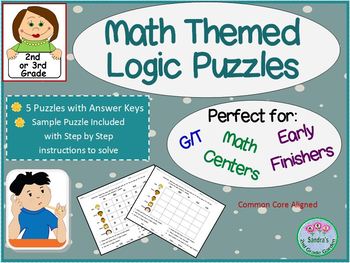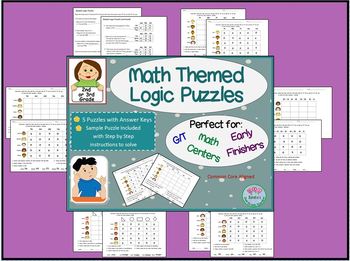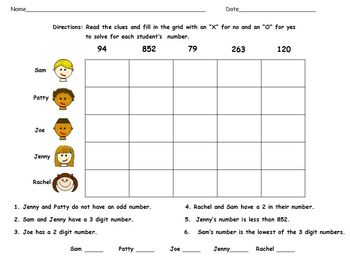Math Themed Logic Puzzles for GT/ and Early Finishers - 2nd or 3rd Grade
Sandra's Always Schooling
484 Followers
Grade Levels
2nd - 3rd
Subjects
Resource Type
Standards
CCSS2.OA.C.3
CCSS2.G.A.1
CCSS3.G.A.1
Formats Included
- PDF
Pages
14 pages
Sandra's Always Schooling
484 Followers
What educators are saying
My high math students loved these puzzles. I used them as a challenge activity and as a way to provide documentation for GT referrals.
I find this tool to be incredibly beneficial in preparing myself for the beginning of the academic year.
Description
Logic puzzles are a great challenge for your G/T students or early finishers!
These math themed puzzles use odd, even, addition, subtraction and attributes of polygons to solve puzzles. Which student has which number? Which student has which shape?
A sample puzzle with step by directions on how to solve logic puzzles are included to introduce your students to the world of logic!
5 Puzzles with answer keys included.
These math themed puzzles use odd, even, addition, subtraction and attributes of polygons to solve puzzles. Which student has which number? Which student has which shape?
A sample puzzle with step by directions on how to solve logic puzzles are included to introduce your students to the world of logic!
5 Puzzles with answer keys included.
Total Pages
14 pages
Answer Key
N/A
Teaching Duration
N/A
Report this resource to TPT
Reported resources will be reviewed by our team. Report this resource to let us know if this resource violates TPT’s content guidelines.
Standards
to see state-specific standards (only available in the US).
CCSS2.OA.C.3
Determine whether a group of objects (up to 20) has an odd or even number of members, e.g., by pairing objects or counting them by 2s; write an equation to express an even number as a sum of two equal addends.
CCSS2.G.A.1
Recognize and draw shapes having specified attributes, such as a given number of angles or a given number of equal faces. Identify triangles, quadrilaterals, pentagons, hexagons, and cubes.
CCSS3.G.A.1
Understand that shapes in different categories (e.g., rhombuses, rectangles, and others) may share attributes (e.g., having four sides), and that the shared attributes can define a larger category (e.g., quadrilaterals). Recognize rhombuses, rectangles, and squares as examples of quadrilaterals, and draw examples of quadrilaterals that do not belong to any of these subcategories.





